Fight Against Anorexia: Phenomenological Analysis of Recovery
VerifiedAdded on 2020/05/28
|52
|12813
|605
Report
AI Summary
This report presents a qualitative, archival study utilizing Interpretative Phenomenological Analysis (IPA) to explore the experiences of women recovering from anorexia nervosa. The study analyzed YouTube videos of six women, focusing on their perceptions and viewpoints regarding the condition and their recovery journeys. The research aimed to understand how individuals view themselves, the factors influencing their self-perception, and the strategies they employ to manage their sense of self. The analysis generated four key themes: experiencing a fragile sense of self, the influence of others, strategies for self-management, and the enduring impact of early experiences. The findings highlight the psychological aspects of anorexia nervosa and the recovery process, providing insights that can aid in understanding and supporting individuals with eating disorders. The report also discusses the methodology, ethical considerations, and limitations of the study. The study's objective was to determine what the individuals felt about experiencing the condition, and what suggestions they have for others in the society. The research questions that were addressed in the research related to the areas of interest were as follows How do the individuals describe and view themselves at present? Did the individuals experience considerable changes in their view of self-image with different people in the society and diverse situations? What were the views of the individuals regarding the contributory factors behind their inclination to view themselves that way? What were the opinion of the individuals regarding why they had a particular perception about themselves and the related experience?
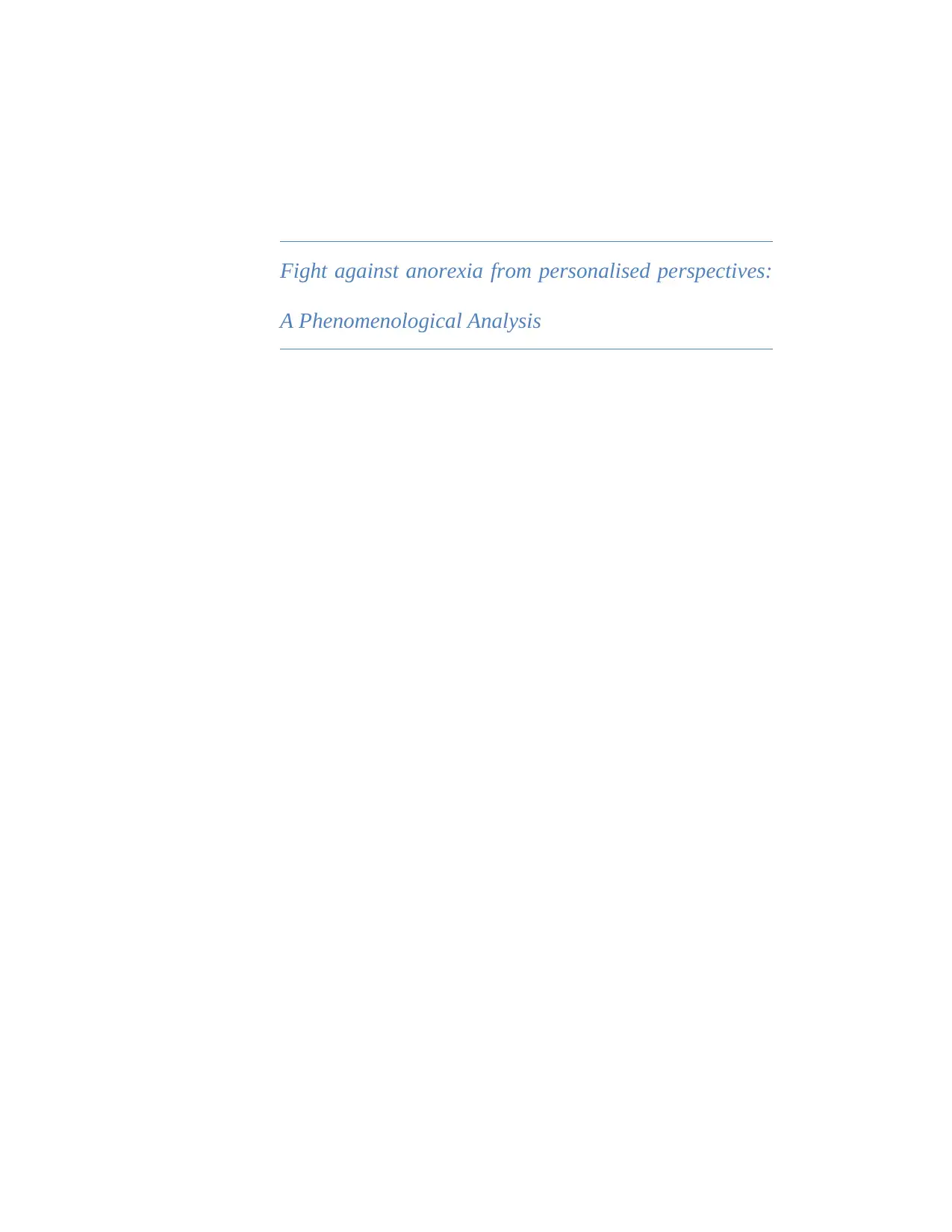
Fight against anorexia from personalised perspectives:
A Phenomenological Analysis
A Phenomenological Analysis
Paraphrase This Document
Need a fresh take? Get an instant paraphrase of this document with our AI Paraphraser
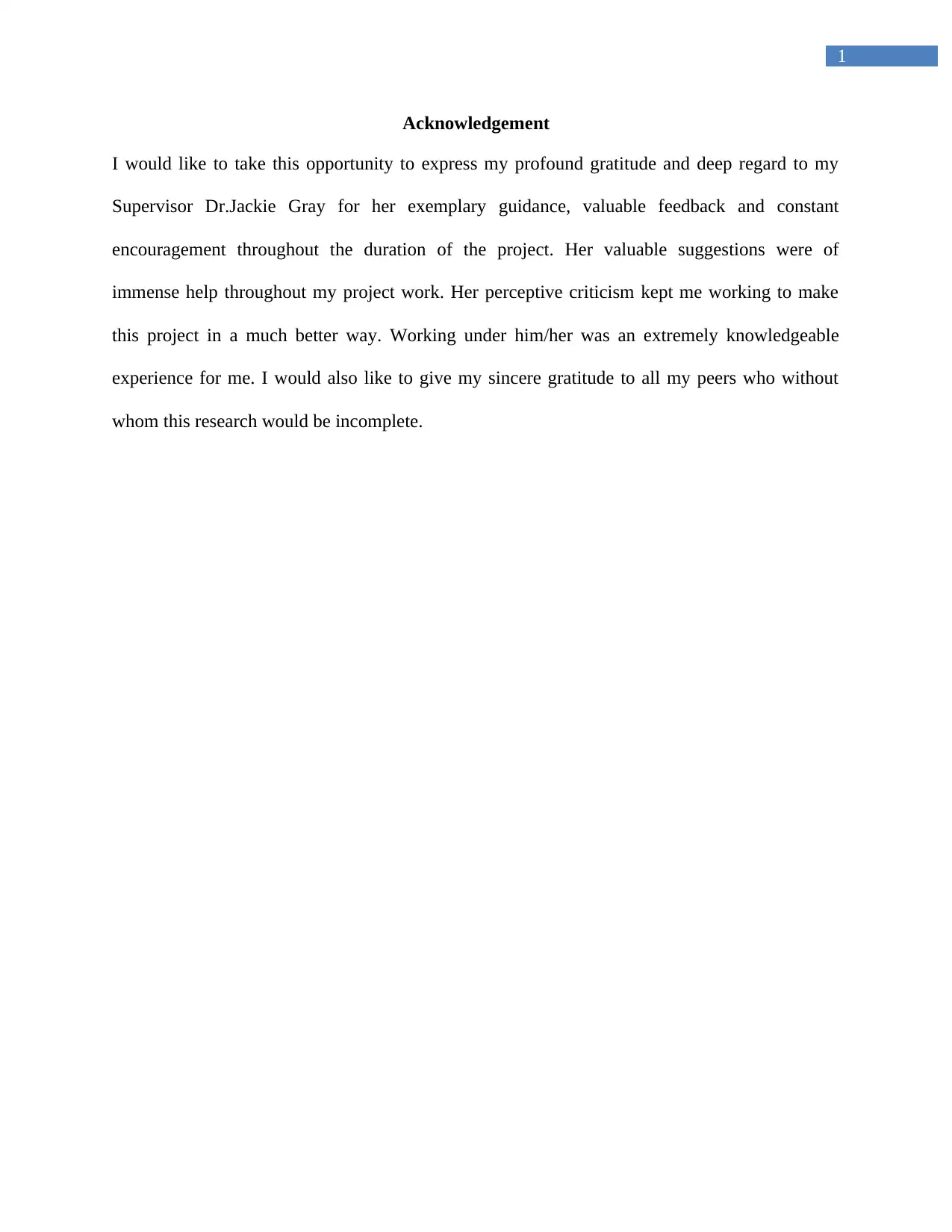
1
Acknowledgement
I would like to take this opportunity to express my profound gratitude and deep regard to my
Supervisor Dr.Jackie Gray for her exemplary guidance, valuable feedback and constant
encouragement throughout the duration of the project. Her valuable suggestions were of
immense help throughout my project work. Her perceptive criticism kept me working to make
this project in a much better way. Working under him/her was an extremely knowledgeable
experience for me. I would also like to give my sincere gratitude to all my peers who without
whom this research would be incomplete.
Acknowledgement
I would like to take this opportunity to express my profound gratitude and deep regard to my
Supervisor Dr.Jackie Gray for her exemplary guidance, valuable feedback and constant
encouragement throughout the duration of the project. Her valuable suggestions were of
immense help throughout my project work. Her perceptive criticism kept me working to make
this project in a much better way. Working under him/her was an extremely knowledgeable
experience for me. I would also like to give my sincere gratitude to all my peers who without
whom this research would be incomplete.
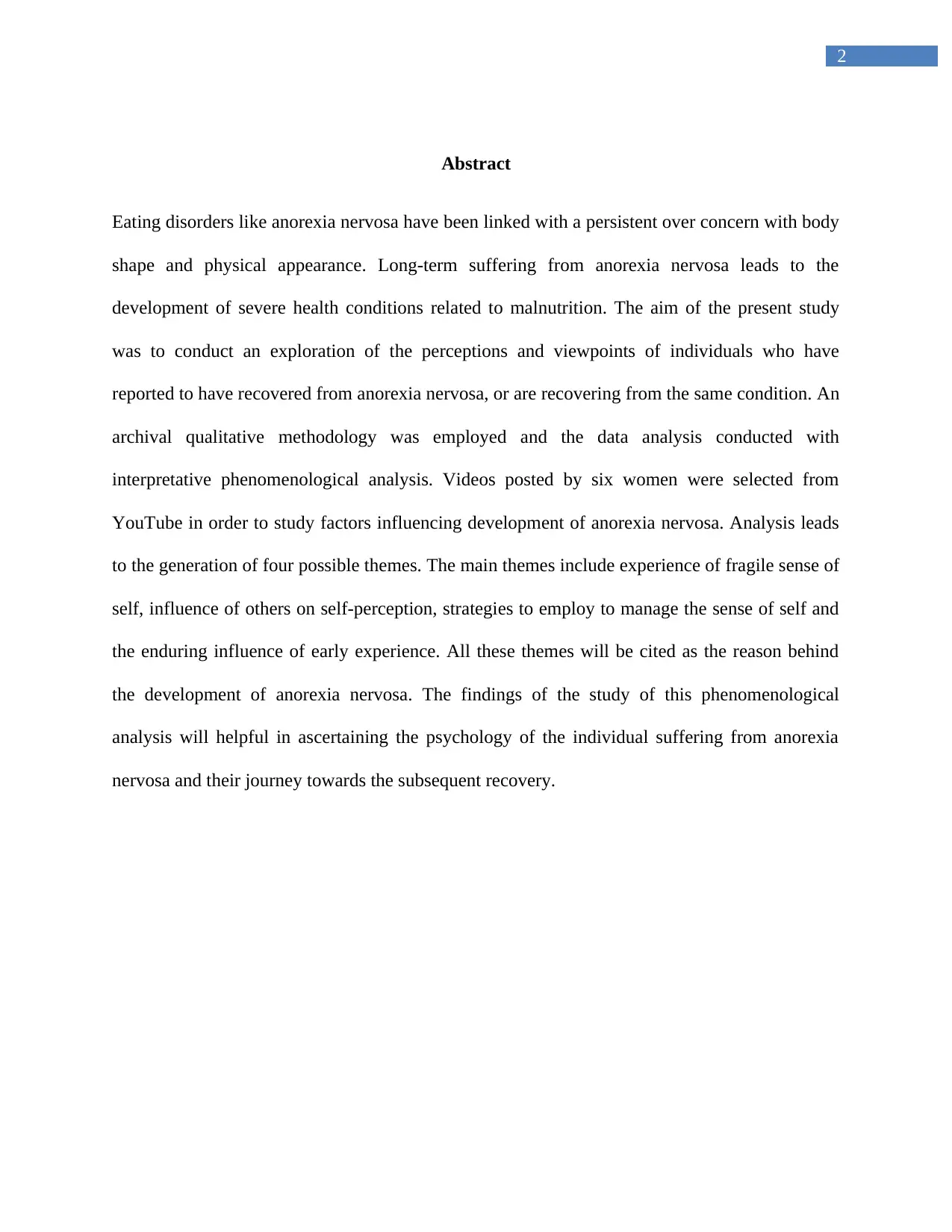
2
Abstract
Eating disorders like anorexia nervosa have been linked with a persistent over concern with body
shape and physical appearance. Long-term suffering from anorexia nervosa leads to the
development of severe health conditions related to malnutrition. The aim of the present study
was to conduct an exploration of the perceptions and viewpoints of individuals who have
reported to have recovered from anorexia nervosa, or are recovering from the same condition. An
archival qualitative methodology was employed and the data analysis conducted with
interpretative phenomenological analysis. Videos posted by six women were selected from
YouTube in order to study factors influencing development of anorexia nervosa. Analysis leads
to the generation of four possible themes. The main themes include experience of fragile sense of
self, influence of others on self-perception, strategies to employ to manage the sense of self and
the enduring influence of early experience. All these themes will be cited as the reason behind
the development of anorexia nervosa. The findings of the study of this phenomenological
analysis will helpful in ascertaining the psychology of the individual suffering from anorexia
nervosa and their journey towards the subsequent recovery.
Abstract
Eating disorders like anorexia nervosa have been linked with a persistent over concern with body
shape and physical appearance. Long-term suffering from anorexia nervosa leads to the
development of severe health conditions related to malnutrition. The aim of the present study
was to conduct an exploration of the perceptions and viewpoints of individuals who have
reported to have recovered from anorexia nervosa, or are recovering from the same condition. An
archival qualitative methodology was employed and the data analysis conducted with
interpretative phenomenological analysis. Videos posted by six women were selected from
YouTube in order to study factors influencing development of anorexia nervosa. Analysis leads
to the generation of four possible themes. The main themes include experience of fragile sense of
self, influence of others on self-perception, strategies to employ to manage the sense of self and
the enduring influence of early experience. All these themes will be cited as the reason behind
the development of anorexia nervosa. The findings of the study of this phenomenological
analysis will helpful in ascertaining the psychology of the individual suffering from anorexia
nervosa and their journey towards the subsequent recovery.
⊘ This is a preview!⊘
Do you want full access?
Subscribe today to unlock all pages.

Trusted by 1+ million students worldwide
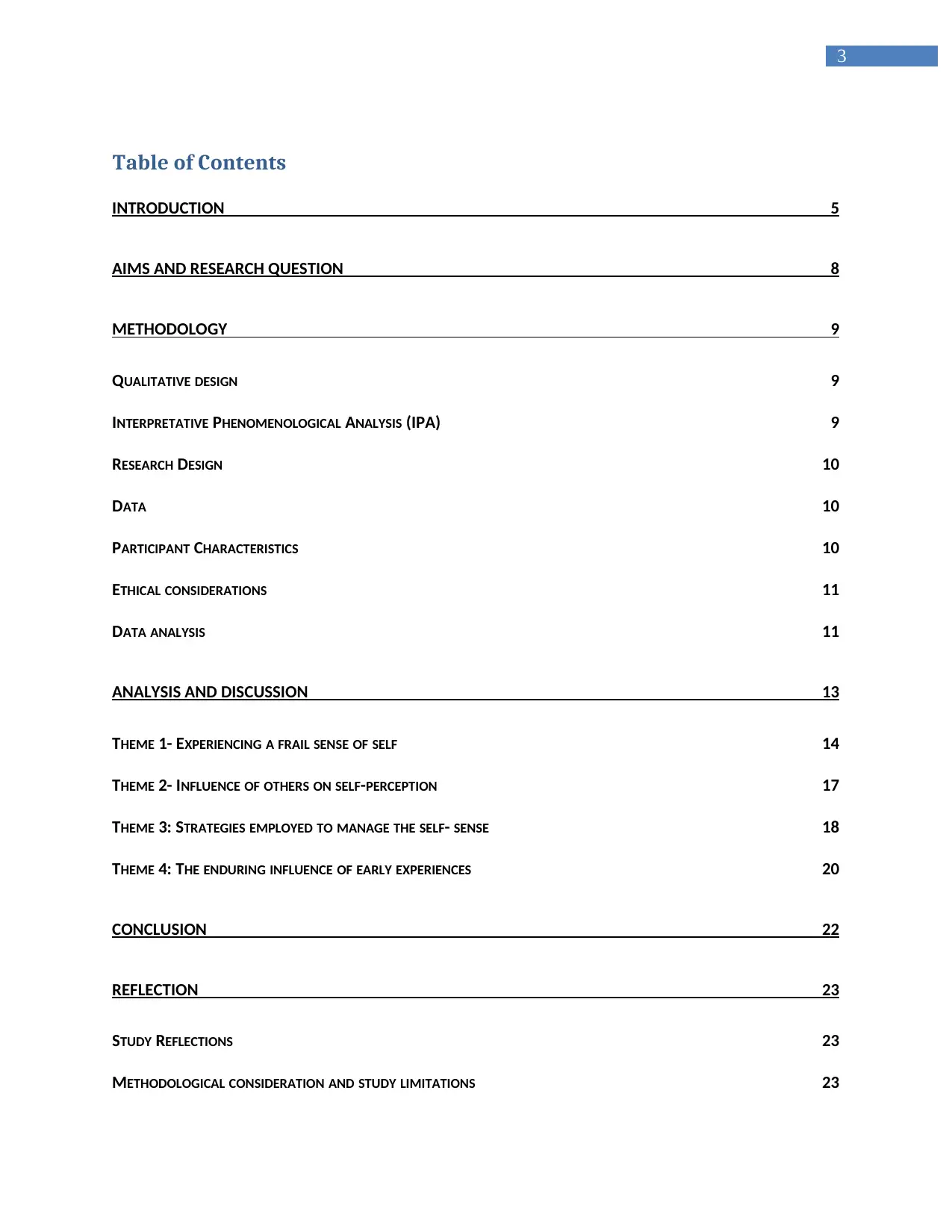
3
Table of Contents
INTRODUCTION 5
AIMS AND RESEARCH QUESTION 8
METHODOLOGY 9
QUALITATIVE DESIGN 9
INTERPRETATIVE PHENOMENOLOGICAL ANALYSIS (IPA) 9
RESEARCH DESIGN 10
DATA 10
PARTICIPANT CHARACTERISTICS 10
ETHICAL CONSIDERATIONS 11
DATA ANALYSIS 11
ANALYSIS AND DISCUSSION 13
THEME 1- EXPERIENCING A FRAIL SENSE OF SELF 14
THEME 2- INFLUENCE OF OTHERS ON SELF-PERCEPTION 17
THEME 3: STRATEGIES EMPLOYED TO MANAGE THE SELF- SENSE 18
THEME 4: THE ENDURING INFLUENCE OF EARLY EXPERIENCES 20
CONCLUSION 22
REFLECTION 23
STUDY REFLECTIONS 23
METHODOLOGICAL CONSIDERATION AND STUDY LIMITATIONS 23
Table of Contents
INTRODUCTION 5
AIMS AND RESEARCH QUESTION 8
METHODOLOGY 9
QUALITATIVE DESIGN 9
INTERPRETATIVE PHENOMENOLOGICAL ANALYSIS (IPA) 9
RESEARCH DESIGN 10
DATA 10
PARTICIPANT CHARACTERISTICS 10
ETHICAL CONSIDERATIONS 11
DATA ANALYSIS 11
ANALYSIS AND DISCUSSION 13
THEME 1- EXPERIENCING A FRAIL SENSE OF SELF 14
THEME 2- INFLUENCE OF OTHERS ON SELF-PERCEPTION 17
THEME 3: STRATEGIES EMPLOYED TO MANAGE THE SELF- SENSE 18
THEME 4: THE ENDURING INFLUENCE OF EARLY EXPERIENCES 20
CONCLUSION 22
REFLECTION 23
STUDY REFLECTIONS 23
METHODOLOGICAL CONSIDERATION AND STUDY LIMITATIONS 23
Paraphrase This Document
Need a fresh take? Get an instant paraphrase of this document with our AI Paraphraser
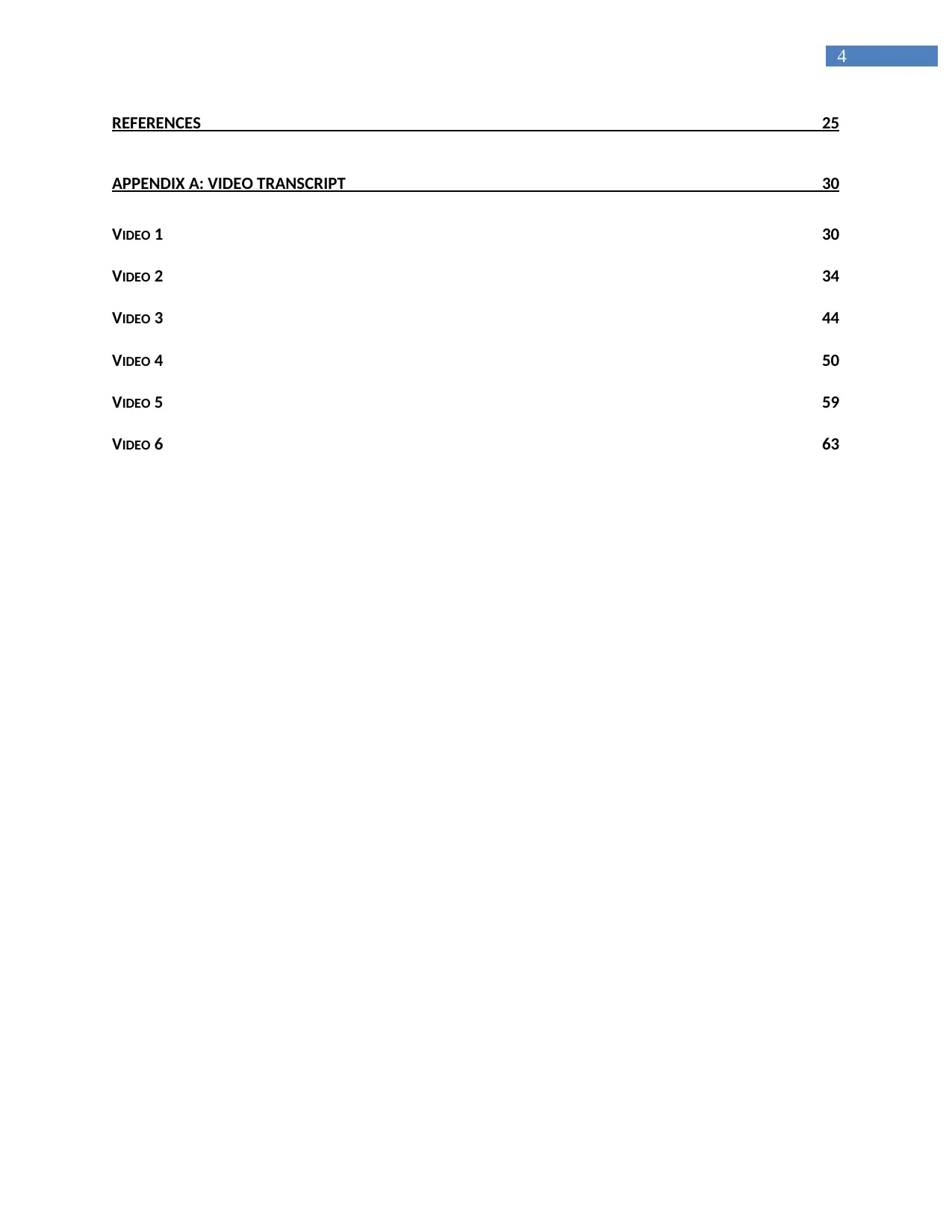
4
REFERENCES 25
APPENDIX A: VIDEO TRANSCRIPT 30
VIDEO 1 30
VIDEO 2 34
VIDEO 3 44
VIDEO 4 50
VIDEO 5 59
VIDEO 6 63
REFERENCES 25
APPENDIX A: VIDEO TRANSCRIPT 30
VIDEO 1 30
VIDEO 2 34
VIDEO 3 44
VIDEO 4 50
VIDEO 5 59
VIDEO 6 63
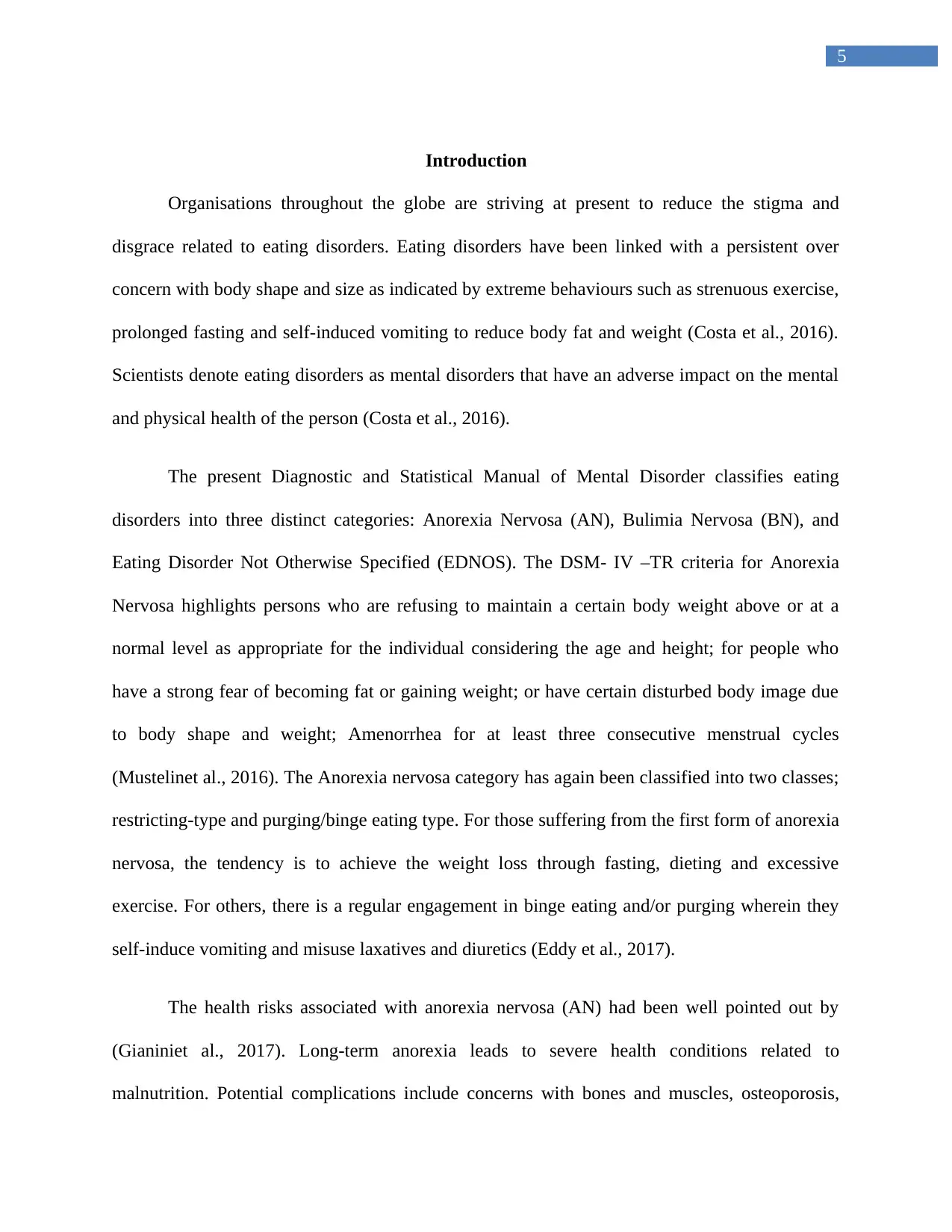
5
Introduction
Organisations throughout the globe are striving at present to reduce the stigma and
disgrace related to eating disorders. Eating disorders have been linked with a persistent over
concern with body shape and size as indicated by extreme behaviours such as strenuous exercise,
prolonged fasting and self-induced vomiting to reduce body fat and weight (Costa et al., 2016).
Scientists denote eating disorders as mental disorders that have an adverse impact on the mental
and physical health of the person (Costa et al., 2016).
The present Diagnostic and Statistical Manual of Mental Disorder classifies eating
disorders into three distinct categories: Anorexia Nervosa (AN), Bulimia Nervosa (BN), and
Eating Disorder Not Otherwise Specified (EDNOS). The DSM- IV –TR criteria for Anorexia
Nervosa highlights persons who are refusing to maintain a certain body weight above or at a
normal level as appropriate for the individual considering the age and height; for people who
have a strong fear of becoming fat or gaining weight; or have certain disturbed body image due
to body shape and weight; Amenorrhea for at least three consecutive menstrual cycles
(Mustelinet al., 2016). The Anorexia nervosa category has again been classified into two classes;
restricting-type and purging/binge eating type. For those suffering from the first form of anorexia
nervosa, the tendency is to achieve the weight loss through fasting, dieting and excessive
exercise. For others, there is a regular engagement in binge eating and/or purging wherein they
self-induce vomiting and misuse laxatives and diuretics (Eddy et al., 2017).
The health risks associated with anorexia nervosa (AN) had been well pointed out by
(Gianiniet al., 2017). Long-term anorexia leads to severe health conditions related to
malnutrition. Potential complications include concerns with bones and muscles, osteoporosis,
Introduction
Organisations throughout the globe are striving at present to reduce the stigma and
disgrace related to eating disorders. Eating disorders have been linked with a persistent over
concern with body shape and size as indicated by extreme behaviours such as strenuous exercise,
prolonged fasting and self-induced vomiting to reduce body fat and weight (Costa et al., 2016).
Scientists denote eating disorders as mental disorders that have an adverse impact on the mental
and physical health of the person (Costa et al., 2016).
The present Diagnostic and Statistical Manual of Mental Disorder classifies eating
disorders into three distinct categories: Anorexia Nervosa (AN), Bulimia Nervosa (BN), and
Eating Disorder Not Otherwise Specified (EDNOS). The DSM- IV –TR criteria for Anorexia
Nervosa highlights persons who are refusing to maintain a certain body weight above or at a
normal level as appropriate for the individual considering the age and height; for people who
have a strong fear of becoming fat or gaining weight; or have certain disturbed body image due
to body shape and weight; Amenorrhea for at least three consecutive menstrual cycles
(Mustelinet al., 2016). The Anorexia nervosa category has again been classified into two classes;
restricting-type and purging/binge eating type. For those suffering from the first form of anorexia
nervosa, the tendency is to achieve the weight loss through fasting, dieting and excessive
exercise. For others, there is a regular engagement in binge eating and/or purging wherein they
self-induce vomiting and misuse laxatives and diuretics (Eddy et al., 2017).
The health risks associated with anorexia nervosa (AN) had been well pointed out by
(Gianiniet al., 2017). Long-term anorexia leads to severe health conditions related to
malnutrition. Potential complications include concerns with bones and muscles, osteoporosis,
⊘ This is a preview!⊘
Do you want full access?
Subscribe today to unlock all pages.

Trusted by 1+ million students worldwide
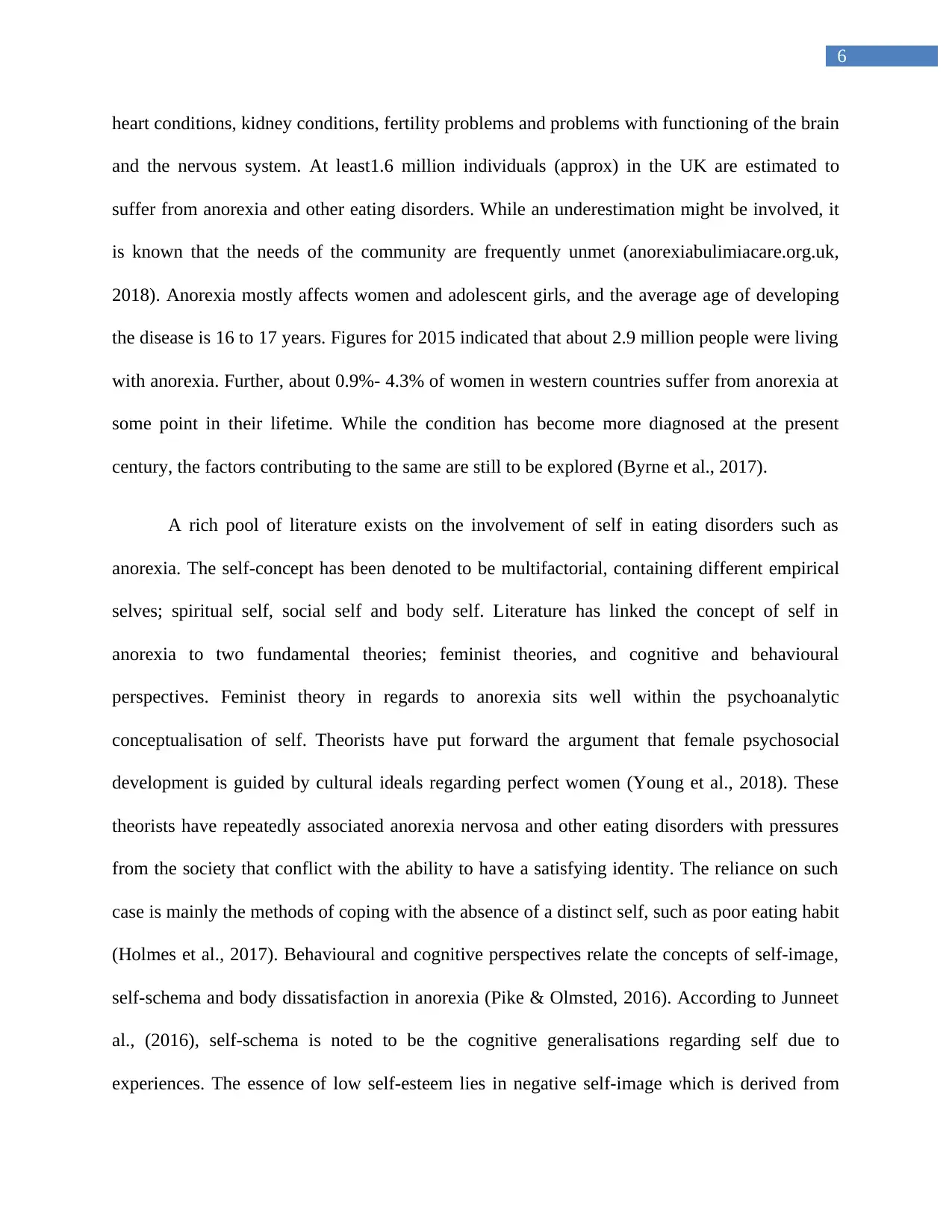
6
heart conditions, kidney conditions, fertility problems and problems with functioning of the brain
and the nervous system. At least1.6 million individuals (approx) in the UK are estimated to
suffer from anorexia and other eating disorders. While an underestimation might be involved, it
is known that the needs of the community are frequently unmet (anorexiabulimiacare.org.uk,
2018). Anorexia mostly affects women and adolescent girls, and the average age of developing
the disease is 16 to 17 years. Figures for 2015 indicated that about 2.9 million people were living
with anorexia. Further, about 0.9%- 4.3% of women in western countries suffer from anorexia at
some point in their lifetime. While the condition has become more diagnosed at the present
century, the factors contributing to the same are still to be explored (Byrne et al., 2017).
A rich pool of literature exists on the involvement of self in eating disorders such as
anorexia. The self-concept has been denoted to be multifactorial, containing different empirical
selves; spiritual self, social self and body self. Literature has linked the concept of self in
anorexia to two fundamental theories; feminist theories, and cognitive and behavioural
perspectives. Feminist theory in regards to anorexia sits well within the psychoanalytic
conceptualisation of self. Theorists have put forward the argument that female psychosocial
development is guided by cultural ideals regarding perfect women (Young et al., 2018). These
theorists have repeatedly associated anorexia nervosa and other eating disorders with pressures
from the society that conflict with the ability to have a satisfying identity. The reliance on such
case is mainly the methods of coping with the absence of a distinct self, such as poor eating habit
(Holmes et al., 2017). Behavioural and cognitive perspectives relate the concepts of self-image,
self-schema and body dissatisfaction in anorexia (Pike & Olmsted, 2016). According to Junneet
al., (2016), self-schema is noted to be the cognitive generalisations regarding self due to
experiences. The essence of low self-esteem lies in negative self-image which is derived from
heart conditions, kidney conditions, fertility problems and problems with functioning of the brain
and the nervous system. At least1.6 million individuals (approx) in the UK are estimated to
suffer from anorexia and other eating disorders. While an underestimation might be involved, it
is known that the needs of the community are frequently unmet (anorexiabulimiacare.org.uk,
2018). Anorexia mostly affects women and adolescent girls, and the average age of developing
the disease is 16 to 17 years. Figures for 2015 indicated that about 2.9 million people were living
with anorexia. Further, about 0.9%- 4.3% of women in western countries suffer from anorexia at
some point in their lifetime. While the condition has become more diagnosed at the present
century, the factors contributing to the same are still to be explored (Byrne et al., 2017).
A rich pool of literature exists on the involvement of self in eating disorders such as
anorexia. The self-concept has been denoted to be multifactorial, containing different empirical
selves; spiritual self, social self and body self. Literature has linked the concept of self in
anorexia to two fundamental theories; feminist theories, and cognitive and behavioural
perspectives. Feminist theory in regards to anorexia sits well within the psychoanalytic
conceptualisation of self. Theorists have put forward the argument that female psychosocial
development is guided by cultural ideals regarding perfect women (Young et al., 2018). These
theorists have repeatedly associated anorexia nervosa and other eating disorders with pressures
from the society that conflict with the ability to have a satisfying identity. The reliance on such
case is mainly the methods of coping with the absence of a distinct self, such as poor eating habit
(Holmes et al., 2017). Behavioural and cognitive perspectives relate the concepts of self-image,
self-schema and body dissatisfaction in anorexia (Pike & Olmsted, 2016). According to Junneet
al., (2016), self-schema is noted to be the cognitive generalisations regarding self due to
experiences. The essence of low self-esteem lies in negative self-image which is derived from
Paraphrase This Document
Need a fresh take? Get an instant paraphrase of this document with our AI Paraphraser
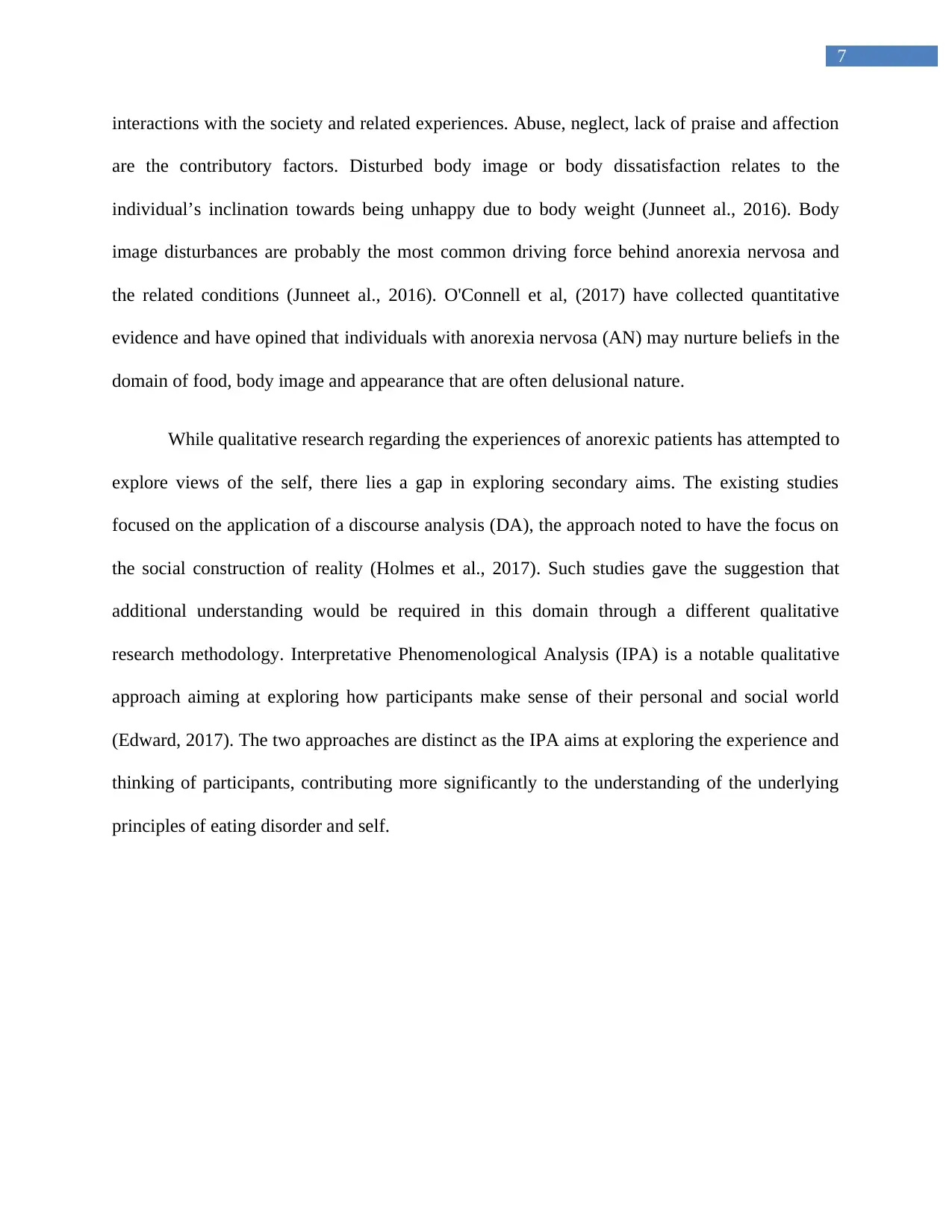
7
interactions with the society and related experiences. Abuse, neglect, lack of praise and affection
are the contributory factors. Disturbed body image or body dissatisfaction relates to the
individual’s inclination towards being unhappy due to body weight (Junneet al., 2016). Body
image disturbances are probably the most common driving force behind anorexia nervosa and
the related conditions (Junneet al., 2016). O'Connell et al, (2017) have collected quantitative
evidence and have opined that individuals with anorexia nervosa (AN) may nurture beliefs in the
domain of food, body image and appearance that are often delusional nature.
While qualitative research regarding the experiences of anorexic patients has attempted to
explore views of the self, there lies a gap in exploring secondary aims. The existing studies
focused on the application of a discourse analysis (DA), the approach noted to have the focus on
the social construction of reality (Holmes et al., 2017). Such studies gave the suggestion that
additional understanding would be required in this domain through a different qualitative
research methodology. Interpretative Phenomenological Analysis (IPA) is a notable qualitative
approach aiming at exploring how participants make sense of their personal and social world
(Edward, 2017). The two approaches are distinct as the IPA aims at exploring the experience and
thinking of participants, contributing more significantly to the understanding of the underlying
principles of eating disorder and self.
interactions with the society and related experiences. Abuse, neglect, lack of praise and affection
are the contributory factors. Disturbed body image or body dissatisfaction relates to the
individual’s inclination towards being unhappy due to body weight (Junneet al., 2016). Body
image disturbances are probably the most common driving force behind anorexia nervosa and
the related conditions (Junneet al., 2016). O'Connell et al, (2017) have collected quantitative
evidence and have opined that individuals with anorexia nervosa (AN) may nurture beliefs in the
domain of food, body image and appearance that are often delusional nature.
While qualitative research regarding the experiences of anorexic patients has attempted to
explore views of the self, there lies a gap in exploring secondary aims. The existing studies
focused on the application of a discourse analysis (DA), the approach noted to have the focus on
the social construction of reality (Holmes et al., 2017). Such studies gave the suggestion that
additional understanding would be required in this domain through a different qualitative
research methodology. Interpretative Phenomenological Analysis (IPA) is a notable qualitative
approach aiming at exploring how participants make sense of their personal and social world
(Edward, 2017). The two approaches are distinct as the IPA aims at exploring the experience and
thinking of participants, contributing more significantly to the understanding of the underlying
principles of eating disorder and self.
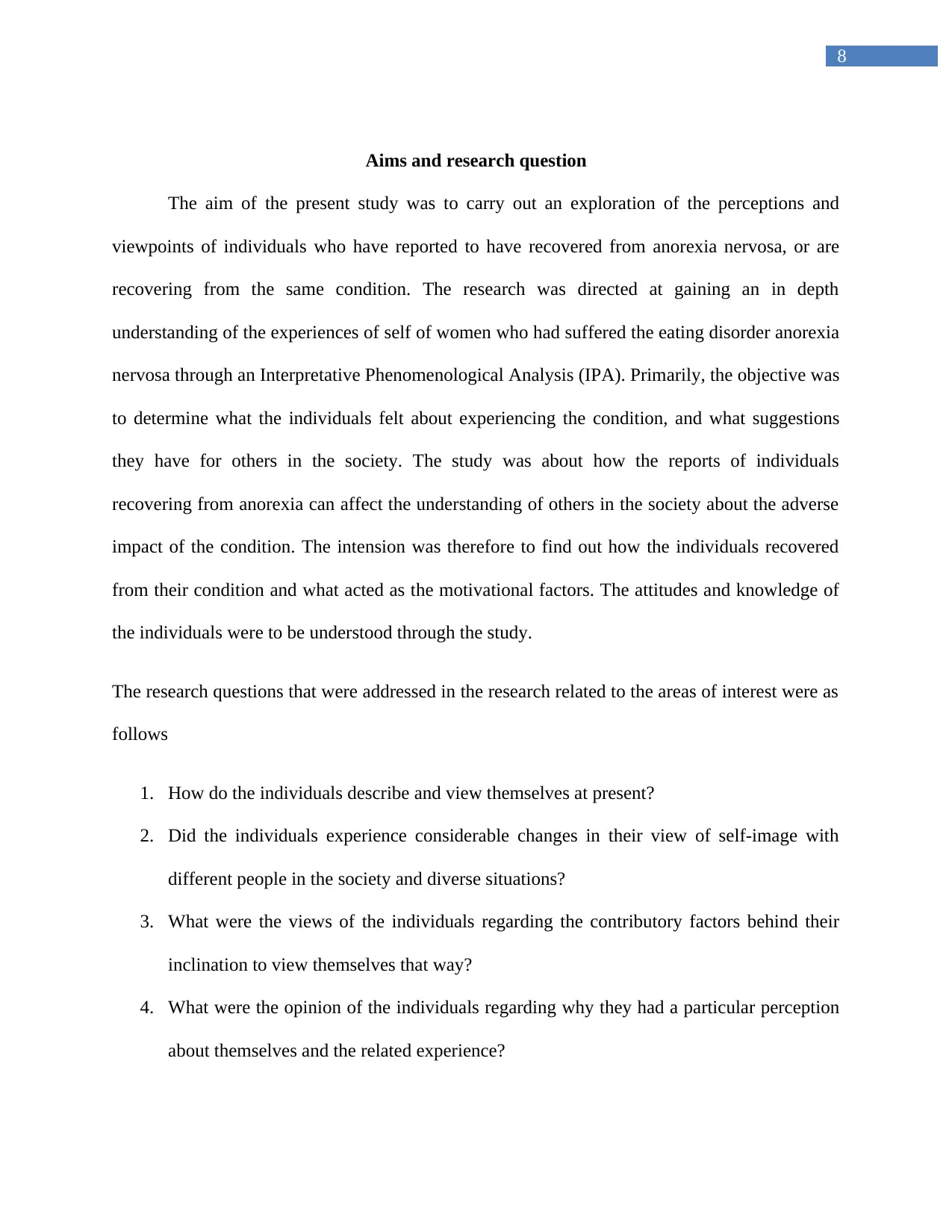
8
Aims and research question
The aim of the present study was to carry out an exploration of the perceptions and
viewpoints of individuals who have reported to have recovered from anorexia nervosa, or are
recovering from the same condition. The research was directed at gaining an in depth
understanding of the experiences of self of women who had suffered the eating disorder anorexia
nervosa through an Interpretative Phenomenological Analysis (IPA). Primarily, the objective was
to determine what the individuals felt about experiencing the condition, and what suggestions
they have for others in the society. The study was about how the reports of individuals
recovering from anorexia can affect the understanding of others in the society about the adverse
impact of the condition. The intension was therefore to find out how the individuals recovered
from their condition and what acted as the motivational factors. The attitudes and knowledge of
the individuals were to be understood through the study.
The research questions that were addressed in the research related to the areas of interest were as
follows
1. How do the individuals describe and view themselves at present?
2. Did the individuals experience considerable changes in their view of self-image with
different people in the society and diverse situations?
3. What were the views of the individuals regarding the contributory factors behind their
inclination to view themselves that way?
4. What were the opinion of the individuals regarding why they had a particular perception
about themselves and the related experience?
Aims and research question
The aim of the present study was to carry out an exploration of the perceptions and
viewpoints of individuals who have reported to have recovered from anorexia nervosa, or are
recovering from the same condition. The research was directed at gaining an in depth
understanding of the experiences of self of women who had suffered the eating disorder anorexia
nervosa through an Interpretative Phenomenological Analysis (IPA). Primarily, the objective was
to determine what the individuals felt about experiencing the condition, and what suggestions
they have for others in the society. The study was about how the reports of individuals
recovering from anorexia can affect the understanding of others in the society about the adverse
impact of the condition. The intension was therefore to find out how the individuals recovered
from their condition and what acted as the motivational factors. The attitudes and knowledge of
the individuals were to be understood through the study.
The research questions that were addressed in the research related to the areas of interest were as
follows
1. How do the individuals describe and view themselves at present?
2. Did the individuals experience considerable changes in their view of self-image with
different people in the society and diverse situations?
3. What were the views of the individuals regarding the contributory factors behind their
inclination to view themselves that way?
4. What were the opinion of the individuals regarding why they had a particular perception
about themselves and the related experience?
⊘ This is a preview!⊘
Do you want full access?
Subscribe today to unlock all pages.

Trusted by 1+ million students worldwide
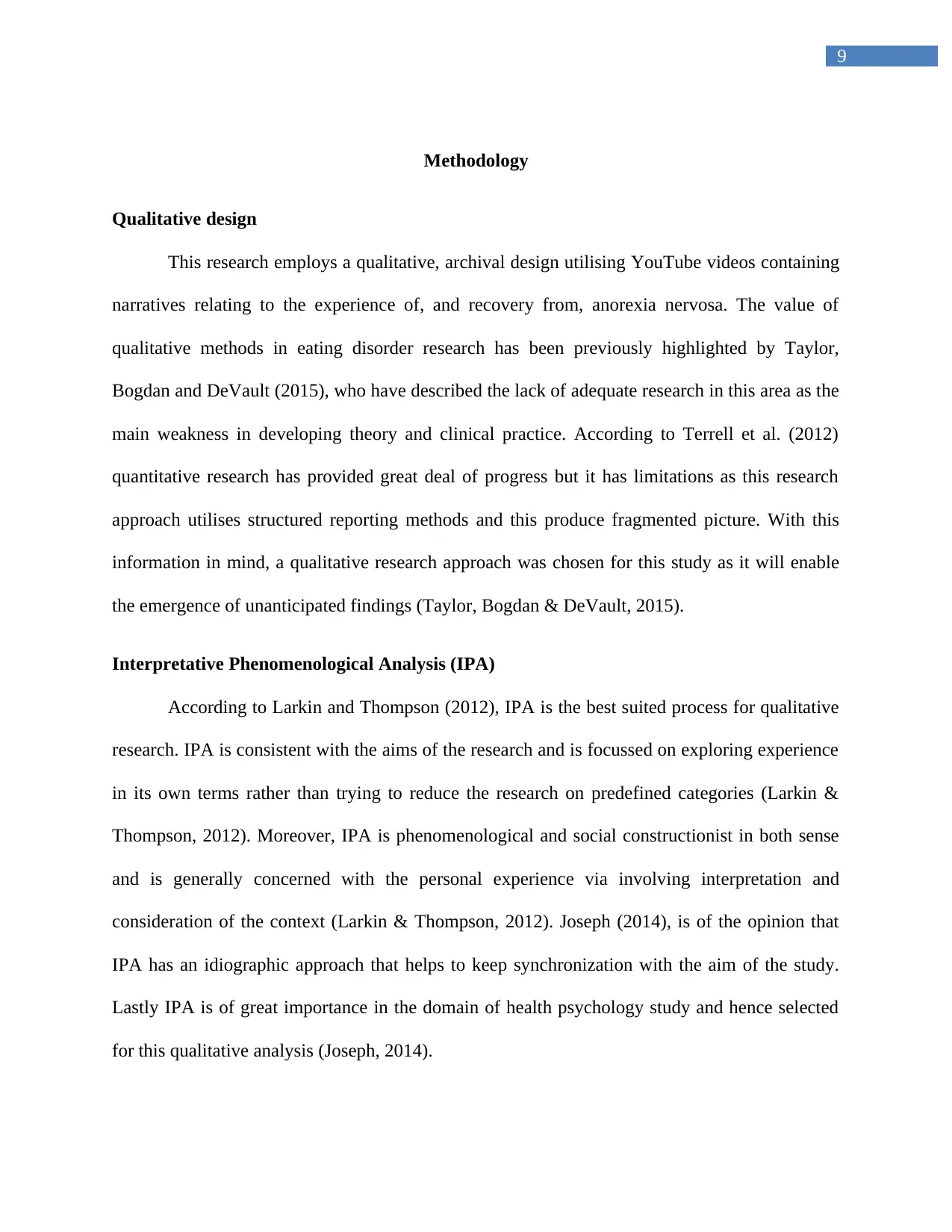
9
Methodology
Qualitative design
This research employs a qualitative, archival design utilising YouTube videos containing
narratives relating to the experience of, and recovery from, anorexia nervosa. The value of
qualitative methods in eating disorder research has been previously highlighted by Taylor,
Bogdan and DeVault (2015), who have described the lack of adequate research in this area as the
main weakness in developing theory and clinical practice. According to Terrell et al. (2012)
quantitative research has provided great deal of progress but it has limitations as this research
approach utilises structured reporting methods and this produce fragmented picture. With this
information in mind, a qualitative research approach was chosen for this study as it will enable
the emergence of unanticipated findings (Taylor, Bogdan & DeVault, 2015).
Interpretative Phenomenological Analysis (IPA)
According to Larkin and Thompson (2012), IPA is the best suited process for qualitative
research. IPA is consistent with the aims of the research and is focussed on exploring experience
in its own terms rather than trying to reduce the research on predefined categories (Larkin &
Thompson, 2012). Moreover, IPA is phenomenological and social constructionist in both sense
and is generally concerned with the personal experience via involving interpretation and
consideration of the context (Larkin & Thompson, 2012). Joseph (2014), is of the opinion that
IPA has an idiographic approach that helps to keep synchronization with the aim of the study.
Lastly IPA is of great importance in the domain of health psychology study and hence selected
for this qualitative analysis (Joseph, 2014).
Methodology
Qualitative design
This research employs a qualitative, archival design utilising YouTube videos containing
narratives relating to the experience of, and recovery from, anorexia nervosa. The value of
qualitative methods in eating disorder research has been previously highlighted by Taylor,
Bogdan and DeVault (2015), who have described the lack of adequate research in this area as the
main weakness in developing theory and clinical practice. According to Terrell et al. (2012)
quantitative research has provided great deal of progress but it has limitations as this research
approach utilises structured reporting methods and this produce fragmented picture. With this
information in mind, a qualitative research approach was chosen for this study as it will enable
the emergence of unanticipated findings (Taylor, Bogdan & DeVault, 2015).
Interpretative Phenomenological Analysis (IPA)
According to Larkin and Thompson (2012), IPA is the best suited process for qualitative
research. IPA is consistent with the aims of the research and is focussed on exploring experience
in its own terms rather than trying to reduce the research on predefined categories (Larkin &
Thompson, 2012). Moreover, IPA is phenomenological and social constructionist in both sense
and is generally concerned with the personal experience via involving interpretation and
consideration of the context (Larkin & Thompson, 2012). Joseph (2014), is of the opinion that
IPA has an idiographic approach that helps to keep synchronization with the aim of the study.
Lastly IPA is of great importance in the domain of health psychology study and hence selected
for this qualitative analysis (Joseph, 2014).
Paraphrase This Document
Need a fresh take? Get an instant paraphrase of this document with our AI Paraphraser
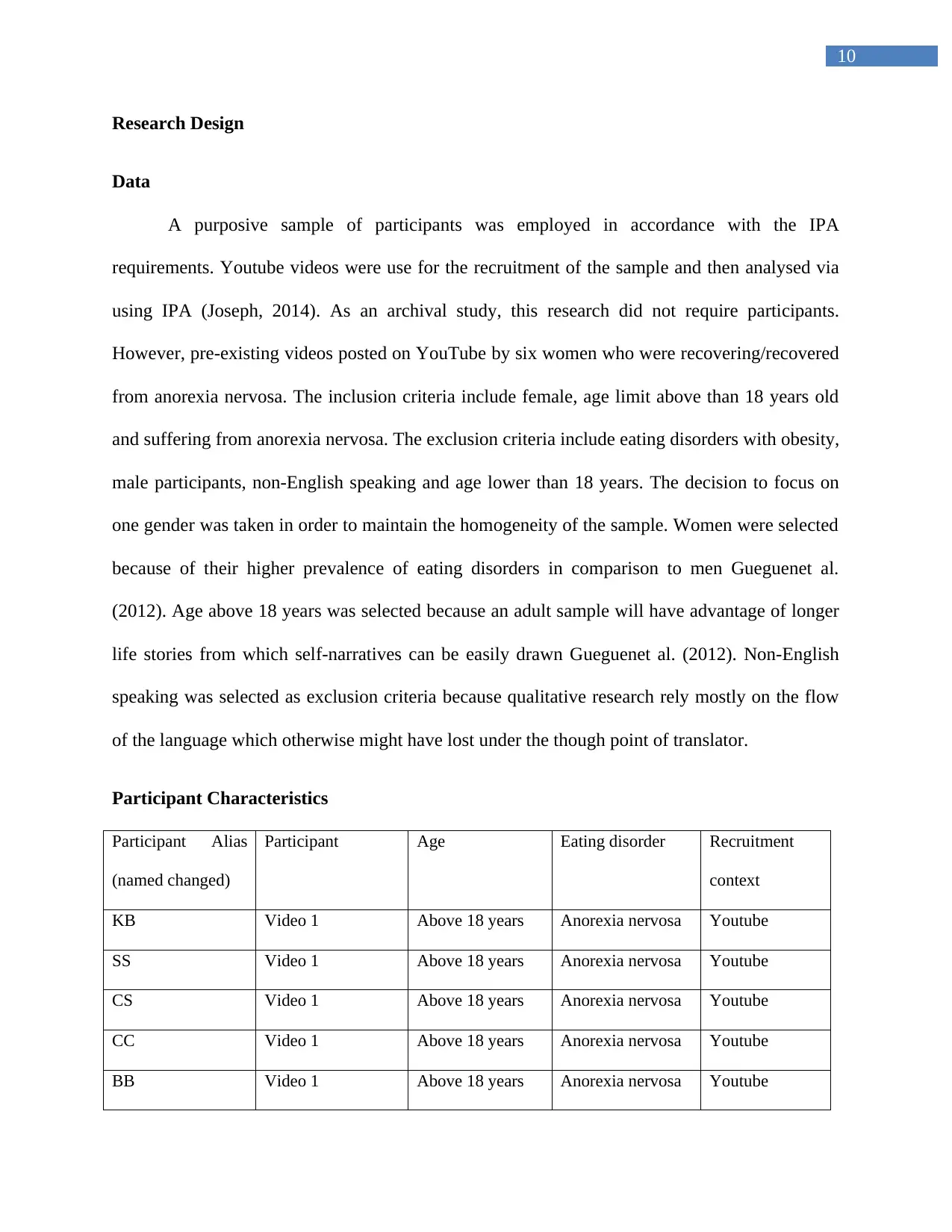
10
Research Design
Data
A purposive sample of participants was employed in accordance with the IPA
requirements. Youtube videos were use for the recruitment of the sample and then analysed via
using IPA (Joseph, 2014). As an archival study, this research did not require participants.
However, pre-existing videos posted on YouTube by six women who were recovering/recovered
from anorexia nervosa. The inclusion criteria include female, age limit above than 18 years old
and suffering from anorexia nervosa. The exclusion criteria include eating disorders with obesity,
male participants, non-English speaking and age lower than 18 years. The decision to focus on
one gender was taken in order to maintain the homogeneity of the sample. Women were selected
because of their higher prevalence of eating disorders in comparison to men Gueguenet al.
(2012). Age above 18 years was selected because an adult sample will have advantage of longer
life stories from which self-narratives can be easily drawn Gueguenet al. (2012). Non-English
speaking was selected as exclusion criteria because qualitative research rely mostly on the flow
of the language which otherwise might have lost under the though point of translator.
Participant Characteristics
Participant Alias
(named changed)
Participant Age Eating disorder Recruitment
context
KB Video 1 Above 18 years Anorexia nervosa Youtube
SS Video 1 Above 18 years Anorexia nervosa Youtube
CS Video 1 Above 18 years Anorexia nervosa Youtube
CC Video 1 Above 18 years Anorexia nervosa Youtube
BB Video 1 Above 18 years Anorexia nervosa Youtube
Research Design
Data
A purposive sample of participants was employed in accordance with the IPA
requirements. Youtube videos were use for the recruitment of the sample and then analysed via
using IPA (Joseph, 2014). As an archival study, this research did not require participants.
However, pre-existing videos posted on YouTube by six women who were recovering/recovered
from anorexia nervosa. The inclusion criteria include female, age limit above than 18 years old
and suffering from anorexia nervosa. The exclusion criteria include eating disorders with obesity,
male participants, non-English speaking and age lower than 18 years. The decision to focus on
one gender was taken in order to maintain the homogeneity of the sample. Women were selected
because of their higher prevalence of eating disorders in comparison to men Gueguenet al.
(2012). Age above 18 years was selected because an adult sample will have advantage of longer
life stories from which self-narratives can be easily drawn Gueguenet al. (2012). Non-English
speaking was selected as exclusion criteria because qualitative research rely mostly on the flow
of the language which otherwise might have lost under the though point of translator.
Participant Characteristics
Participant Alias
(named changed)
Participant Age Eating disorder Recruitment
context
KB Video 1 Above 18 years Anorexia nervosa Youtube
SS Video 1 Above 18 years Anorexia nervosa Youtube
CS Video 1 Above 18 years Anorexia nervosa Youtube
CC Video 1 Above 18 years Anorexia nervosa Youtube
BB Video 1 Above 18 years Anorexia nervosa Youtube
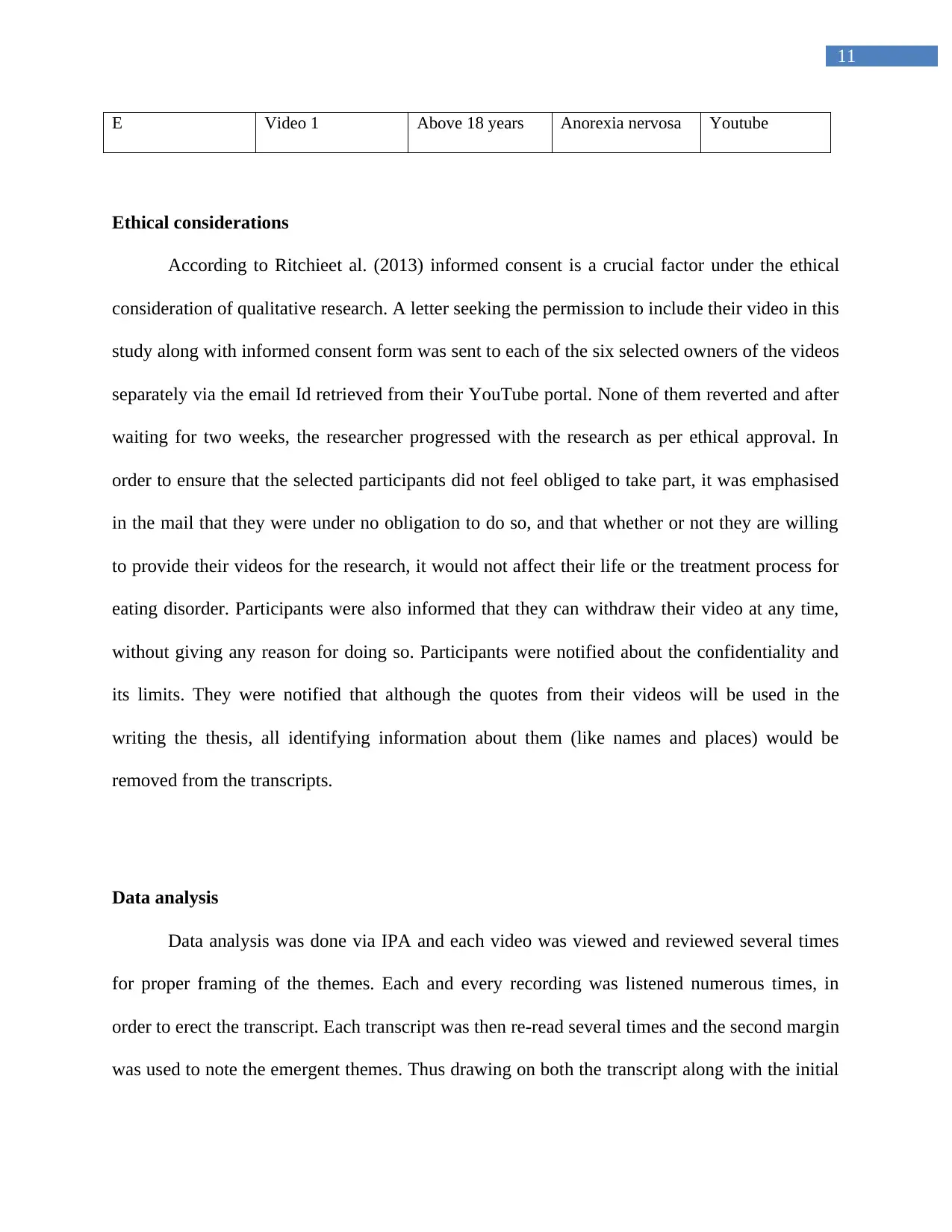
11
E Video 1 Above 18 years Anorexia nervosa Youtube
Ethical considerations
According to Ritchieet al. (2013) informed consent is a crucial factor under the ethical
consideration of qualitative research. A letter seeking the permission to include their video in this
study along with informed consent form was sent to each of the six selected owners of the videos
separately via the email Id retrieved from their YouTube portal. None of them reverted and after
waiting for two weeks, the researcher progressed with the research as per ethical approval. In
order to ensure that the selected participants did not feel obliged to take part, it was emphasised
in the mail that they were under no obligation to do so, and that whether or not they are willing
to provide their videos for the research, it would not affect their life or the treatment process for
eating disorder. Participants were also informed that they can withdraw their video at any time,
without giving any reason for doing so. Participants were notified about the confidentiality and
its limits. They were notified that although the quotes from their videos will be used in the
writing the thesis, all identifying information about them (like names and places) would be
removed from the transcripts.
Data analysis
Data analysis was done via IPA and each video was viewed and reviewed several times
for proper framing of the themes. Each and every recording was listened numerous times, in
order to erect the transcript. Each transcript was then re-read several times and the second margin
was used to note the emergent themes. Thus drawing on both the transcript along with the initial
E Video 1 Above 18 years Anorexia nervosa Youtube
Ethical considerations
According to Ritchieet al. (2013) informed consent is a crucial factor under the ethical
consideration of qualitative research. A letter seeking the permission to include their video in this
study along with informed consent form was sent to each of the six selected owners of the videos
separately via the email Id retrieved from their YouTube portal. None of them reverted and after
waiting for two weeks, the researcher progressed with the research as per ethical approval. In
order to ensure that the selected participants did not feel obliged to take part, it was emphasised
in the mail that they were under no obligation to do so, and that whether or not they are willing
to provide their videos for the research, it would not affect their life or the treatment process for
eating disorder. Participants were also informed that they can withdraw their video at any time,
without giving any reason for doing so. Participants were notified about the confidentiality and
its limits. They were notified that although the quotes from their videos will be used in the
writing the thesis, all identifying information about them (like names and places) would be
removed from the transcripts.
Data analysis
Data analysis was done via IPA and each video was viewed and reviewed several times
for proper framing of the themes. Each and every recording was listened numerous times, in
order to erect the transcript. Each transcript was then re-read several times and the second margin
was used to note the emergent themes. Thus drawing on both the transcript along with the initial
⊘ This is a preview!⊘
Do you want full access?
Subscribe today to unlock all pages.

Trusted by 1+ million students worldwide
1 out of 52
Your All-in-One AI-Powered Toolkit for Academic Success.
+13062052269
info@desklib.com
Available 24*7 on WhatsApp / Email
![[object Object]](/_next/static/media/star-bottom.7253800d.svg)
Unlock your academic potential
Copyright © 2020–2025 A2Z Services. All Rights Reserved. Developed and managed by ZUCOL.